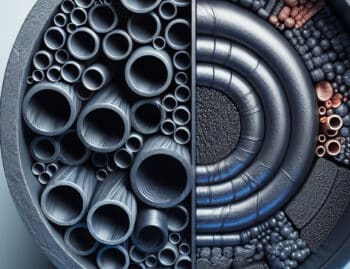Coke is used as a fuel and a reducing agent in melting iron ore. It is produced by baking coal until it becomes carbon by burning off impurities without burning up the coal itself. When coke is consumed it generates intense heat but little smoke, making it ideal for smelting iron and steel. Prior to the 1880’s, steel was produced using charcoal. By 1920, nearly 90% of US steel was produced using coke.
Coke processes
Coke is made by either by-product or non-recovery methods.
In by-product coke, impurities are baked off at between 1800-3600 degrees Fahrenheit to leave almost pure carbon. The ovens used must admit no oxygen to avoid reaction with other elements that could leave impurities. As the coal is “coked” it softens to a liquid, but solidifies to a porous material on cooling. The gases produced in the coke process are piped off to a by-product plant where they can be collected for other uses.
In non-recovery (or heat recovery), the ovens are stacked in a beehive shape and heated from the top as air is fed through the bottom for combustion. Hot waste gases are sent to a boiler to create steam (heat recovery) or not used at all (non-recovery).
Blast Furnace Injection
The 1960s saw the injection of pulverized coal when melting steel or iron in a blast furnace. This provided additional energy to burn off gases and prevent iron oxide (rust), as well as reduce coke consumption. By the 1990s coal use became the norm.
Typically coal preparation involves drying and grinding coal to tiny particles of less than 1mm for injection. The coal particles are separated from released gases in a cyclone. The waste gas, and sometimes natural gas, can be used for drying additional coal, which is generally kept below 6% moisture content. Inert gases are used to minimize the risk of fire or ignition of the coal particles.
Quality of coal
In either coke or non-coked coal, the quality of the coal affects the quality of the steel. Metallurgical coke is made from bituminous coals by a distillation process. Ash deposited by the coal must be kept to a minimum, preferably below 10% of the original mass. The ash can lower furnace temperatures and leave non-combustible materials. Coals are also chosen for a higher amount of volatile sulfur or alkali content that helps it burn more completely. In practice, however, the coal used often depends on availability and price.
Though the coal industry have gotten some bad press over the years, coal is essential to steel production, and our civilization is heavily reliant on steel. Without it we would not have our vehicles, tall buildings, appliances, or many of the tools and utensils we take for granted every day.











